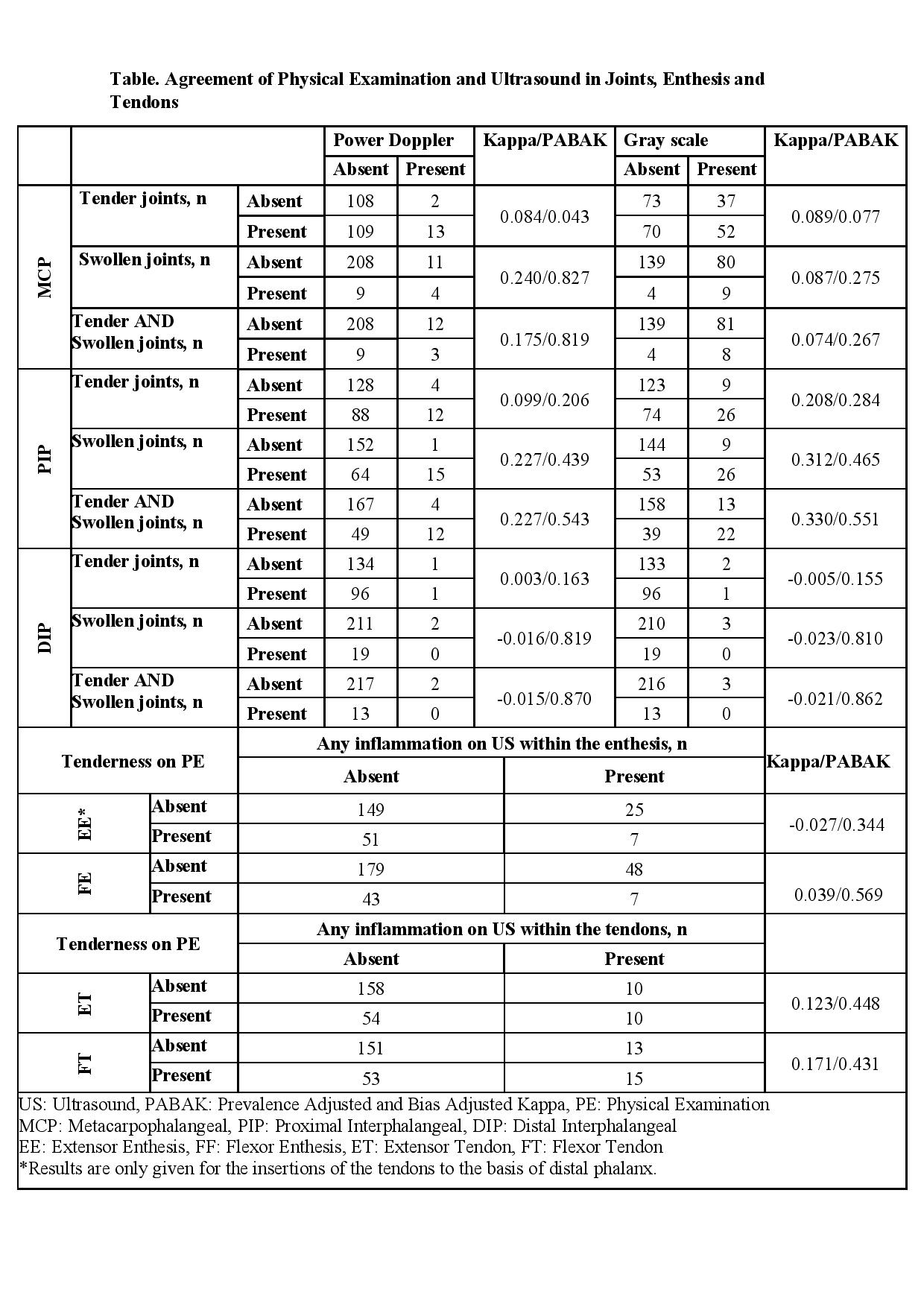Session Information
Date: Friday, November 6, 2020
Session Type: Poster Session A
Session Time: 9:00AM-11:00AM
Background/Purpose: The aim of this study to explore the comparison of physical examination (PE) and ultrasound (US) detected synovial and extra-synovial pathologies of the hands in psoriatic arthritis (PsA).
Methods: Twenty-nine PsA patients who had hand pain included the study. A detailed PE was performed to differentiate pain due to joint, tendon, and entheseal disease. At the same visit US scans of MCP (Metacarpophalangeal), PIP (Proximal Interphalangeal), DIP (Distal Interphalangeal) joints (total 696 joints), extensor and flexor tendons (464) and enthesis (696) of 2nd to 5th fingers of both hands were done by an investigator blinded to the clinical assessment. The agreement between PE and US findings was calculated with Kappa and Prevalence Adjusted and Bias Adjusted Kappa (PABAK).
Results: Fifteen of the patients were male, the mean age was 54.8 (8.4) and the mean PsA duration was 15.3 (10) years. Tender joint count was detected highest in MCP joints [n=122 (52.5%)] in 27 (93%) patients and swollen joint count was highest in PIP joints [n=79 (34%)] in 23 (79%) patients. Power Doppler (PD) positivity rate was similar in MCP (n=15, 6.5% of the joints; 7/29, 24% of the patients) and PIP joints (n=16, 7% of the joints; 8/29, 27.5 %) of the patients), but Gray Scale (GS) positivity was found highest in MCP joints [n=89, (38.4%)] and in 24 (83%) patients. Overall DIP joints had low GS and PD positivity rates (1.3% and 0.9%, respectively). Strongest agreement for joints was between “swollen joints”, “tender and swollen joints” and PD in the MCP joints and GS in the PIP joints (Table). The agreement of tender entheses on PE and inflammation on US (hypoechogenicity, thickening and/or PD signals) was poor for both extensor (Kappa= -0.027 PABAK= 0.344) and flexor compartments (Kappa= 0.039 PABAK= 0.569). Similar to enthesitis, for the tendons, comparison of any PE and US findings showed a poor agreement at the extensor and flexor regions (extensor: Kappa= 0.123, PABAK= 0.448 and flexor: Kappa= 0.171, PABAK= 0.431).
Conclusion: Our study showed that there is a poor to fair agreement of PE and US findings of hands, for the joints, tendons, and entheses which may all be involved in PsA. US can add value when determining the source of pain in PsA in the small joints.
To cite this abstract in AMA style:
Gazel U, Solmaz D, Ayan G, Ivory C, Karsh J, Aydin S. Accuracy of Physical Examination to Detect Synovial and Extra-synovial Pathologies in Psoriatic Arthritis in Comparison to Ultrasonography [abstract]. Arthritis Rheumatol. 2020; 72 (suppl 10). https://acrabstracts.org/abstract/accuracy-of-physical-examination-to-detect-synovial-and-extra-synovial-pathologies-in-psoriatic-arthritis-in-comparison-to-ultrasonography/. Accessed .« Back to ACR Convergence 2020
ACR Meeting Abstracts - https://acrabstracts.org/abstract/accuracy-of-physical-examination-to-detect-synovial-and-extra-synovial-pathologies-in-psoriatic-arthritis-in-comparison-to-ultrasonography/

